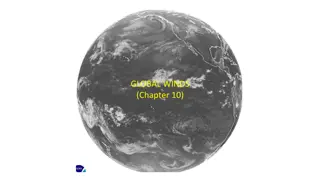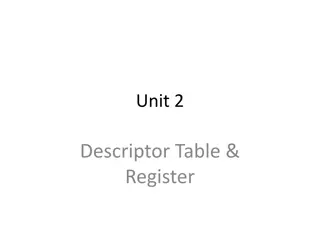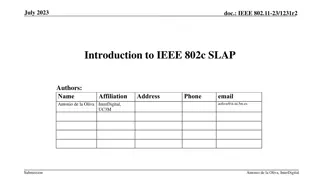Global and Local Winds
Global and local winds are created by differences in air pressure due to unequal heating of the atmosphere. Wind formation involves the movement of air from high to low pressure areas, influenced by factors like the Coriolis effect. The composition, structure, and properties of the atmosphere play crucial roles in shaping wind patterns, as illustrated by the Coriolis effect's impact on wind direction in different hemispheres.
Download Presentation

Please find below an Image/Link to download the presentation.
The content on the website is provided AS IS for your information and personal use only. It may not be sold, licensed, or shared on other websites without obtaining consent from the author.If you encounter any issues during the download, it is possible that the publisher has removed the file from their server.
You are allowed to download the files provided on this website for personal or commercial use, subject to the condition that they are used lawfully. All files are the property of their respective owners.
The content on the website is provided AS IS for your information and personal use only. It may not be sold, licensed, or shared on other websites without obtaining consent from the author.
E N D
Presentation Transcript
Global and Local Winds i
What causes wind? Caused by a difference in air pressure due to unequal heating of the atmosphere.
Winds are created by. Heating the air, decreases pressure (warm air rises creating a low pressure) Cool air rushes into replace the warm air (cooler dense air, produces high pressure) As air goes from high to low pressure, winds form.
Coriolis Effect Coriolis Effect Rotation of the Earth causes moving air and water to change directions Northern Hemisphere winds curve to the right Southern Hemisphere winds curve to the left. http://www.youtube.com/watch?v=mcPs_OdQOYU
Do Now In Binders Describe how wind is created. What is the relationship between density and pressure? What happens to air pressure as I hike up a mountain? What instrument measures air pressure?
Global Winds What roles do composition, structure, and properties play in our atmosphere?
Coriolis Effect Because the Earth rotates, and consists of a mixture of land and sea, the Coriolis Effect exists The Coriolis Effect causes air movement to: Move to the RIGHT in the Northern Hemisphere Move to the LEFT in the SOUTHERN Hemisphere
Global Winds Global wind patterns are caused by: Coriolis Effect The land and sea makeup of Earth
90 60 30 Warm Moist Air Rises 0 30 60
90 60 30 Cool Dry Air Sinks Warm Moist Air Rises 0 30 Cool Dry Air Sinks 60
90 60 Cold Moist Air Rises 30 Cool Dry Air Sinks Warm Moist Air Rises 0 30 Cool Dry Air Sinks Cold Moist Air Rises 60
90 Very Cold Air Sinks 60 Cold Moist Air Rises 30 Cool Dry Air Sinks Warm Moist Air Rises 0 30 Cool Dry Air Sinks Cold Moist Air Rises 60 Very Cold Air Sinks
H 90 Very Cold Air Sinks L 60 Cold Moist Air Rises H 30 Cool Dry Air Sinks L Warm Moist Air Rises 0 30 Cool Dry Air Sinks H Cold Moist Air Rises L 60 Very Cold Air Sinks H
H 90 L 60 H 30 L 0 30 H Wind Moves from HIGH to LOW L 60 H
Objects are deflected to the RIGHT in the Northern Hemisphere 90 60 30 0 30 60
Global Winds Don t travel North and South because of the Earth rotating on its axis. 4 Types of Global Winds Doldrums Trade Winds Prevailing Westerlies Polar Easterlies
Remember! Wind gets its name from the direction it is blowing FROM!
Doldrums These are located at the equator, surface winds are calm and weak. Why are they called doldrums? Sailors found that there were no winds near the equator for a period of time. The ships were essentially stuck in one place, not being able to move forward. These calm periods were called doldrums. Today, to be stuck in the doldrums means that you d like to be doing something, but you re stuck waiting for something to happen so you can begin moving forward.
Trade Winds Named from their ability to quickly propel trading ships across the ocean - found between about 30 latitude and the equator - steady and blow about 11 to 13 mph - In the Northern Hemisphere, the trade winds blow from the northeast and are known as the Northeast Trade Winds - In the Southern Hemisphere, the winds blow from the southeast and are called the Southeast Trade Winds.
Prevailing Westerlies Strong winds Located in the belt from 30-60 degrees latitude in both hemispheres. Has an impact on the US weather
Polar Easterlies Cold, but weak winds Near the north and south poles US weather is influenced by these Cooling takes place between the 50-60 degree latitude as it approaches the poles
Northern Wind Patterns Polar Easterlies 90 60 latitude from the east Prevailing Westerlies 60 30 latitude from the west Trade winds 30 0 latitude from the East
Latitude Nicknames Horse Latitudes 30 latitude Named because the boats stalled and the horses had to go! Doldrums / Intertropical Convergence Zone (ITCZ) Equator Trade winds converge from north and south Named because boats also got stranded here
Jet Streams Jet Streams format latitudes where wind systems come together High speed westerly winds form high above the surface
There are 2 types of winds 1. Local Winds 2. Global Winds
Jet Stream Discovered in 1940 s Can be found in the upper troposphere Strong high speed and high pressure Moves west to east across the US, moving storms
What brings certain weather phenomenon? El Nino La Nina occurs when the surface temperature rises above the normal water temperature in the Equatorial Pacific Ocean creating more humidity in the atmosphere Known to increase number of hurricanes Occur more frequently (every 3- 7 years) occurs when the surface temperature falls below the normal water temperature in the Equatorial Pacific Ocean creating a more dry atmosphere Known to create drought conditions
Local Winds Cover short distances Blow from any direction 2 Types of Local Winds Sea Breezes- from sea to land Land Breezes from land to sea






















